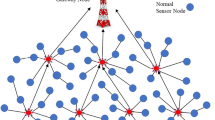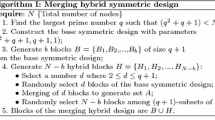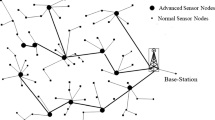Abstract
The majority of security systems for wireless sensor networks are based on symmetric encryption. The main open issue for these approaches concerns the establishment of symmetric keys. A promising key distribution technique is the random pre-distribution of secret keys. Despite its effectiveness, this approach presents considerable memory overheads, in contrast with the limited resources of wireless sensor networks. A new scheme, called Seed based Min–Max Composite (S2MC), is proposed that exploits the best features of random pre-distribution with lower memory requirements and higher resilience. The novelty of the S2MC scheme lies in the organization of the secret material that uses the limited number of light weight pre-distributed seeds in a certain range and generating keys from the seeds during communication. The simulative analysis demonstrates that the introduced approach provides a higher level of security in terms of resilience than the existing schemes since the keys are erased after communication in the presence of compromised nodes.







Similar content being viewed by others
References
Zhang, Z., Mehmood, A., Shu, L., Huo, Z., Zhang, Y., & Mukherjee, M. (2018). A survey on fault diagnosis in wireless sensor networks. IEEE Access, 6, 11349–11364.
Choi, J., Bang, J., Kim, L. H., Ahn, M., & Kwon, T. (2017). Location-based key management strong against insider threats in wireless sensor networks. IEEE Systems Journal, 11(2), 494–502.
Yousefpoor, M. S., & Barati, H. (2018). Dynamic key management algorithms in wireless sensor networks: A survey. Computer Communications, COMCOM 5796.
Wazid, M., Das, A. K., & Vasilakos, A. V. (2018). Authenticated key management protocol for cloud-assisted body area sensor networks. Journal of Network and Computer Applications, YJNCA 2208.
Zhan, F., Yao, N., Gao, Z., & Tan, G. (2017). A novel key generation method for wireless sensor networks based on system of equations. Journal of Network and Computer Applications, 82, 114–127.
Xu, M., & Liu, L. (2018). Sensevault: A three-tier framework for securing mobile underwater sensor networks. IEEE Transactions on Mobile Computing, 17(11), 2632–2645.
Agrawal, S., & Das, M. L. (2017). Mutual healing enabled group-key distribution protocol in wireless sensor networks. Computer Communications, 112, 131–140.
Athmani, S., Bilami, A., & Boubiche, D. E. (2017). EDAK: An efficient dynamic authentication and key management mechanism for heterogeneous WSNs. Future Generation Computer Systems, FUTURE 3765.
Seo, S. H., Won, J., Sultana, S., & Bertino, E. (2015). Effective key management in dynamic wireless sensor networks. Information Forensics and Security, IEEE Transactions on, 10(2), 371–383.
Ahlawat, P., & Dave, M. (2018). An attack model based highly secure key management scheme for wireless sensor networks. Procedia Computer Science, 125, 201–207.
Jiang, Q., Zeadally, S., Ma, J., & He, D. (2017). Lightweight three-factor authentication and key agreement protocol for internet-integrated wireless sensor networks. IEEE Access, 5, 3376–3392.
Al-Turjman, F., Ever, Y. K., Ever, E., Nguyen, H. X., & David, D. B. (2017). Seamless key agreement framework for mobile-sink in IoT based cloud-centric secured public safety sensor networks. IEEE Access, 5, 24617–24631.
Omar, M., Belalouache, I., Amrane, S., & Abbache, B. (2018). Efficient and energy-aware key management framework for dynamic sensor networks. CAEE, 1–16.
Anita, E. A. M., Geetha, R., & Kannan, E. (2015). A novel hybrid key management scheme for establishing secure communication in wireless sensor networks. Wireless Personal Communications, 82(3), 1419–1433.
Bechkit, W., Challal, Y., Bouabdallah, A., & Tarokh, V. (2013). A highly scalable key pre-distribution scheme for wireless sensor networks. IEEE Transaction Wireless Communication, 12(2).
Eltoweissy, M., Moharrum, M., & Mukkamala, R. (2006). Dynamic key management in sensor networks. IEEE Communication Magazine, 44(4), 122–130.
Gandino, F., Montrucchio, B., & Rebaudengo, M. (2014). Key management for static wireless sensor networks with node adding. IEEE Transaction on Industrial Informatics, 10(2), 1133–1143.
Guan, Z., & Yu, Y. (2008). A key management scheme using deployment knowledge for wireless sensor networks. IEEE Transaction on Parallel and Distribrituted System, 19(10), 1411–1425.
Hackmann, G., Guo, W., Yan, G., Sun, Z., Lu, C., & Dyke, S. (2014). Cyber-physical co-design of distributed structural health monitoring with wireless sensor networks. IEEE Transaction on Parallel and Distributed System, 25(1), 63–72.
Kwon, T., Lee, J., & Song, J. (2009). Location-based pair-wise key pre-distribution for wireless sensor networks. IEEE Transaction on Wireless Communication, 8(11), 5436–5442.
Seo, S. H., Won, J., Sultana, S., & Bertino, E. (2015). Effective key management in dynamic wireless sensor networks. IEEE Transaction on Information Forensics and Security, 10(2), 371–383.
Du, W., Deng, J., Han, Y. S., & Varshney, P. K. (2006). A key pre-distribution scheme for sensor networks using deployment knowledge. IEEE Transactions on Dependable and Secure Computing, 3(1), 62–77.
Yu, C. M., Sou, Y. T. T., Lu, C. S., & Kuo, S. Y. (2013). Localized algorithms for detection of node replication attacks in mobile sensor networks. IEEE Transaction on Information Forensics and Security, 8(5), 754–768.
Yum, D., & Lee, P. J. (2012). Exact formulae for resilience in random key pre-distribution scheme. IEEE Transaction on Wireless Communication, 11(5), 1638–1642.
Rasheed, A., & Mahapatra, R. (2011). Keypredistribution schemes for establishing pairwise keys with a mobile sink in sensor networks. IEEE Transactions on Parallel and Distributed Systems, 22(1), 176–184.
Das, A. K. (2011). An efficient random key distribution scheme for largescale distributed sensor networks. Security and Communication Networks, 4(2), 162–180.
Zhu, S., Setia, S., & Jajodia, S. (2006). Leap+: Efficient security mechanisms for large-scale distributed sensor networks. ACM Transactions on Sensor Networks, 2(4), 500–528.
Author information
Authors and Affiliations
Corresponding author
Additional information
Publisher's Note
Springer Nature remains neutral with regard to jurisdictional claims in published maps and institutional affiliations.
Rights and permissions
About this article
Cite this article
Geetha, R., Madhusudhan, V., Padmavathy, T. et al. A Light Weight Secure Communication Scheme for Wireless Sensor Networks. Wireless Pers Commun 108, 1957–1976 (2019). https://doi.org/10.1007/s11277-019-06503-x
Published:
Issue Date:
DOI: https://doi.org/10.1007/s11277-019-06503-x




